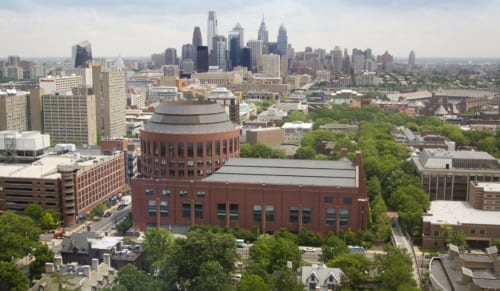https://vimeo.com/217757330
Helping paint the picture of where we’re going together
 In our next installment of interviews with higher education Chief Information Officers, I spoke with Dan Alig, CIO at the prestigious Wharton School of the University of Pennsylvania.
In our next installment of interviews with higher education Chief Information Officers, I spoke with Dan Alig, CIO at the prestigious Wharton School of the University of Pennsylvania.
Established in 1881 with a $100,000 donation from noted business tycoon Joseph Wharton, the school is not only the oldest business school in the U.S. but also one of the most respected, ranking at or near the top of all “best of” surveys year after year.
The average GMAT score of a Wharton student is 730, second only to Stanford, meaning that Dan has a lot of bright young minds to work with in his position as CIO. Alig addresses how lucky he feels to be at a school where students and faculty embrace a spirit of drive and innovation.
It’s a freeing atmosphere that is open to all kinds of new ideas – allowing for the partnering of technology with learning at the highest level.
Interview Transcript:
Dr. Berger: Dan, you were just saying off-air that it’s a wonderful view you have there at Wharton, a historic campus behind you.
I think that’s a nice place to start as we’re talking about being a CIO in higher education and sort of the juxtaposition of tradition and technology and the ways in which education is changing.
How often are you reminded when you’re making decisions or, at least, recommendations of the way in which technology needs to be presented to faculty, students, alumni, and decision makers throughout the campus so that you’re taking into account not only tradition but thoughtfulness and you’re purchasing and integrating in technology that has a standing leg in the future?
 Dan Alig: Absolutely. I have only to look behind me at the historic quad where all the freshmen live to think about how long we’ve done what we’ve done as a university and as a school.
Dan Alig: Absolutely. I have only to look behind me at the historic quad where all the freshmen live to think about how long we’ve done what we’ve done as a university and as a school.
In some ways, I’m lucky at the Wharton School. We were the world’s first collegiate school of business. And so, we transitioned that into an ethos of innovation. We did it first and that’s still the way we think.
As we think about the future of higher education, the future of learning, and the future of the academy, we’re really trying to remain in the context of that spirit and think about how we lead that charge on how we do things first and how we help work with our colleagues across other schools and think differently about what we do.
And that’s very much driven by technology at this point. The global classroom couldn’t exist without the network, without the Internet, and without the way we communicate.
I’m very lucky to work in a place like this where that spirit of drive and innovation exists and where the school is a great partner and technology is a great partner in the school to think differently about how we do what we do.
DB: It’s very interesting to me, speaking with other CIOs around the country, in the role marketing plays in their day to day. Truly, you may be a CIO but you also have a little bit of a CMO in your DNA ─ or you have to ─ in the ways in which you communicate different messages and value propositions and/or when you’re making a tough decision to change a course with some technology. A lot of technology takes time to adopt, and that’s a challenge we all have.
Tell me what it’s like to be a key messenger.
DA: In the CIO role, it is all about communication at this point. It’s building the relationships. It’s about helping our communities understand what’s possible and helping paint the picture of where we’re going together.
I think the other component to that marketing story is the data. How do we think about the data that we have? How do we reach the right people? How do we connect them together? And how do we get the right information to them at the right time?
That starts when we’re looking for the bright students that we want to admit. That starts when we’re looking for the faculty we want to bring to the school to help create the knowledge that we’re going to disseminate. And that goes throughout the whole process as we’re working with them to empower them in the learning process and the discovery process, and then ─ after they’re gone ─ into thinking about how we remain connected to them in that lifelong process of learning.
When you’re admitted to the Wharton School, it’s not for a two- or a four-year degree. It’s to be enabled as a business person for the future. And it’s the future of what they’re going to do; it’s the future of what the world is going to become that we enable.
Having them be part of that conversation with us ─ with our faculty ─ is critically important. And that data of marketing communication is critical to that whole process.
DB: Dan, let’s talk a little bit about form versus function. I think it’s really interesting. We look at the evolution of technology K-20. We have the blips on the screen where if it was shiny and it made noises, then, that was attractive and we got buy in. If it was functional yet not very visibly appealing or engaging, at least it was functional.
How do you break that down when you’re looking at something because there are lot of shiny bells and whistles out there that we could be tempted with but I would imagine you have to take a deeper dive to say, “Okay, this looks great but it is not going to integrate with our other systems or it’s going to be a short-term win and we can’t be thinking in that way especially at Wharton”?
 DA: We always need to find that balance because they are the new and shiny that we need to understand, and we need to find the resources within the organization to experiment. We need to acknowledge them. We need to understand how they’re going to impact what we do.
DA: We always need to find that balance because they are the new and shiny that we need to understand, and we need to find the resources within the organization to experiment. We need to acknowledge them. We need to understand how they’re going to impact what we do.
You can list the buzzwords in technology these days: blockchain, VR, AR and across the board. But it’s now that we start thinking about the impact that they could have on what we do.
Without taking the time to understand them inherently, to bring them in-house and experiment, and really try to see in person how they’re going to affect what we do, we’re not going to be able to imagine the classroom a year from now or ─ four years, five, six, seven ─ a decade from now.
I think we all understand that it doesn’t look the same as it does today. It doesn’t look the same as it did a hundred years ago when the school was just getting off the ground. But these technologies are all going to impact what we do.
And it’s in the experimentation that we understand what we plan for in five years.
DB: Speaking of that experimentation, how can we do a better job of communicating the willingness of higher education to technologists that you want to test things out and that you want to experiment?
I think that there’s this fear of failure from the technologist side that says, “Higher ed will accept nothing but perfection from the word ‘go’ and we’re just deathly afraid that even if we win a contract or a pilot, if we’re not good right out of the gate, we’re going to lose steam.”
And yet, I think we’re all missing an opportunity to learn of new innovators. It’s not always a legacy system that’s going to get us to where we want to go.
DA: I have these conversations with startups all the time about how higher education will respond to them and how we need to be sold to. In a lot of cases, you’re not selling to every CIO at every institution. You are looking for the experimenters. You are looking for the pioneers.
At the end of the day, that exploration and the sustainable process aren’t the same. But it really is incumbent on the higher-ed CIO to go out and initiate those conversations that aren’t always being started.
It’s developing good relationships with the big players and understanding that when Apple releases its latest and brightest watch or wearable, it’s going to pop up on campus. And being part of that early conversation can help extend the dialogue for what it might look like as part of the educational process.
We owe it to ourselves to be proactive in those respects. We can’t expect industry to come reach out to us especially considering that the big bucks aren’t in higher education. And we those conversations, too, about how we generate the pipeline of the future of business as well, where the investments they make in higher education help inform the workforce.
And so, I think higher education is the ecosystem that defines the future of what our learners do in the workforce.
DB: I would think that there’s a potential that in higher education, you have students; you have data; you have things that can be very important to innovators, startups, and even mid-sized technology companies that are trying to grow, quite frankly.
And so, can’t there be a little bit of an exchange knowing that you have a contained student body where that data could be very important for that technology company to be able to share? And yet, do they know that they have that at their disposal to engage somebody like you or other CIOs where you say, “We understand there may not be big bucks interfacing with higher education, but there are some really good pieces that can help you build your business. We can win from a technology standpoint. We all win in the end”?
 DA: Further in that conversation in helping them understand, now is the time in higher education. We all realize that what we do today isn’t going to look the same in a year.
DA: Further in that conversation in helping them understand, now is the time in higher education. We all realize that what we do today isn’t going to look the same in a year.
To your previous point about that willingness to experiment and the openness to the downside risks, I think we are increasingly growing more and more open to that because we know that it’s going to change. And we can either help be a part of that conversation and help lead it or we can get lost.
I think having that conversation with corporations and helping them understand that there is this willingness to experiment where our bottom line and the returns on our investments aren’t measured the same as they are in corporations.
There is a willingness to experiment. It doesn’t exist in corporate America. Partnered with the fact that they can work with our students, understand how their products are used and build the corporate citizens of tomorrow, it’s a win-win situation.
DB: Let’s talk a little bit about retention and change the conversation. Schools that are not Wharton have challenges out there because the brand is teetering on the edge of new education opportunities for students. They’re trying to be much more creative.
But there’s a certain level of school that, by sheer name and brand and tradition, may or may not experience some of the same retention issues or challenges.
What are some lessons that state-run schools can take from institutions like a Wharton or an MIT or University of Chicago and say, “Okay, here’s what they’re doing to not only retain their students but to engage them with technology that meets them where they are in the role that you play as a CIO?
How can we connect the dots to better impact positively higher institutions that are not with the backdrop that you have behind your window there?
DA: Whenever I go to an academic conference and there’s a startup thinking about a retention issue and they hear that I’m from Wharton and Penn and they say, “Oh, you don’t need us.”
And I’ll say, “No, absolutely, we do. We tend to retain fairly well but it’s the same tools that go into empowering. The Wharton education is not a bargain basement price, either. And so, our students need to get what they’re paying for. And the return on that investment is held to a higher standard than it may be elsewhere.
And so, the same tools that go into helping students remain engaged at the other end of the spectrum go into helping push the higher end further up.
And it comes back to that data conversation. It comes back to understanding what we know about them and using that to give them a better experience. It comes back to us using technology to more efficiently and effectively provision the entities that they experience.
This is something that we think very much through when we’re thinking about the classes they take. Even with MOOCs, students aren’t coming here to watch a video of the faculty member; they’re coming here to engage thought leaders.
We still can’t clone our faculty ,but we can make sure that we allocate those resources more efficiently.
Thinking through the technical algorithms that we create schedules with, we’re able to give more students the classes that they need to be successful and the faculty that they need to interact with to get the most out of their degree.
And it’s the same conversation that you have when you have a school that’s trying to get students out the door in four or five years. It’s about the efficient allocation of those scarce resources and maximizing the outcomes.
DB: Dan, from your perspective and your legacy in what you’ve been doing, let’s forecast a little bit. Let’s put you in a seat where you’re looking outward and you’re saying, “Here’s what I think we should be paying attention to but I’m not seeing it in the press; I’m not seeing it at conferences.”
But when we’re talking about technology ─ whether it’s retention, you name it ─ what is it that we should be paying attention to that we’re not, that you think really begs our attention?
 DA: I think, in our business, the core product is always going to be something that validates what you know. Right now, that’s a degree. And I think it’s thinking through as students are learning, as students and lifelong learners are coming into the Wharton tent. How do we measure and demonstrate what they’re learning?
DA: I think, in our business, the core product is always going to be something that validates what you know. Right now, that’s a degree. And I think it’s thinking through as students are learning, as students and lifelong learners are coming into the Wharton tent. How do we measure and demonstrate what they’re learning?
The degree is the start of that, and I think it’s the measurement of all those other outcomes.
For every engagement that you have in a classroom, for every engagement that you have where you learn something, how are we measuring that? How are we demonstrating that? How are we validating and verifying that?
And so, this is where some of the new and buzzier technologies like “blockchain” may play a role in what we do. How do we create these units of measurable learning that can then be portable throughout somebody’s career?
The degree is a big chunk of that. The Wharton degree is a starting point. But the components that you build on that and how we think through what those are have a technical component because there is the ability to track, to measure, and to verify.
DB: To that point, what can K-12 do to better support you in your role? To me, it’s not just about putting the band-aid on; it’s also saying, “Okay, if we’re going to develop a chain of students and teachers and really just the culture of education, that transparency, documenting what we’re learning, and assessment really start in K-12. Then, they’re really accustomed to it. And you can, then, be very creative in the higher-end level, and then on to professional practice.”
 DA: I would say that a lot of that starts with engagement. I have the luxury of being in a big city having conversations with the school district in Philadelphia and with other local private schools ─ my daughter’s school.
DA: I would say that a lot of that starts with engagement. I have the luxury of being in a big city having conversations with the school district in Philadelphia and with other local private schools ─ my daughter’s school.
I think coming to the mutual understanding of how they’re applying technology and how they’re helping students engage in a career of learning informs what we do in higher education.
It’s always impressive to walk through some of these schools and see how they’re thinking about the knowledge available to their students through the network and how they’re empowering that in ways that we haven’t even thought about.
We’re a hundred and thirty plus years old and we’re fairly set in our ways and students are showing up from these schools expecting the understanding of what they want in a much different way.
I think that engagement is critical and I think the more we separate ourselves and think about that separation ─ But it is K-20 at this point.
It isn’t about what happens at that gap. It’s how we continue that process and further develop them so that they’re ready for a career and a continued learning process.
DB: Speaking of engagement, would it be fair to add in the term “transparency” or “transparency in learning” to what you’re talking about?
DA: Absolutely. There’s the availability of information that’s changing the world. It’s not the printing press. It’s not the textbook. It’s the Internet.
I think we’ve only begun to grasp the way in which it’s impacting what we do. And I think there are so many opportunities to engage that knowledge transfer in different ways and in more transparent ways that enable that ongoing process. And that process that shouldn’t end when they leave us.
DB: I think it’s incredibly interesting and I’m glad that you’re connecting the dots saying that it’s truly K-20 in this space.
What is your favorite piece of technology even if it’s just in your personal life? What is it that you enjoy and you say, “Boy, if I could just have this at work, this would be great”?
DA: I really enjoy home automation at this point. I have young kids and watching them interact with home automation through verbal commands ─ and so, our Amazon Echo has a seat at the dinner table with us.
Watching kids who can’t necessarily read what’s on the screen but can interact with technology and the effects of that; watching my daughter learn to enunciate better because she wants to be able to control the technology and the growth that’s happening through things that we don’t understand. Learning from a five-year-old how technology might impact higher education ─ it’s just so much fun.
And the ability to adopt these things as a consumer and to change the way we interact with the world around us is just so exciting.
About Dan Alig:
Dan Alig, Chief Information Officer, leads Wharton Computing in delivering IT resources to faculty, students, staff and alumni and developing strategies to enhance the School’s mission with technology.
Alig began working at Wharton in 1999, supporting technology for the Graduate Division and has since moved through a variety of job functions with progressively increasing responsibility. Most recently he served as a Senior IT Director for Administrative Technology, where his teams oversaw the systems and services that helped run the business of the School.
A Los Angeles native, Alig moved to Philadelphia to study Computer Science at the School of Engineering and Applied Science at the University of Pennsylvania.
This article was originally posted in the Huffington Post .
Author
Dr. Berger is one of many industry education correspondents for the Mind Rocket Media Group, An educator and former school administrator. His video interview work and conversational podcasts have been featured in various media outlets. He often hosts education panel discussions and develops strategic content. As an academic Dr. Berger is a guest lecturer at Vanderbilt University’s Owen Graduate School of Management. A former assistant principal, he has been an adjunct undergraduate professor and developer of online college courses. He is a passionate Detroit sports fan who has also adopted Nashville sports teams as his own.
Contact the Mind Rocket Media Group if you are interested in an industry interview and a placement on EdCircuit.
- Harvard Business Review – Why Higher Ed and Business Need to Work Together
- University Business – Success-tech triumphs in higher ed
- Inside Higher Ed – Are we in the data business?
